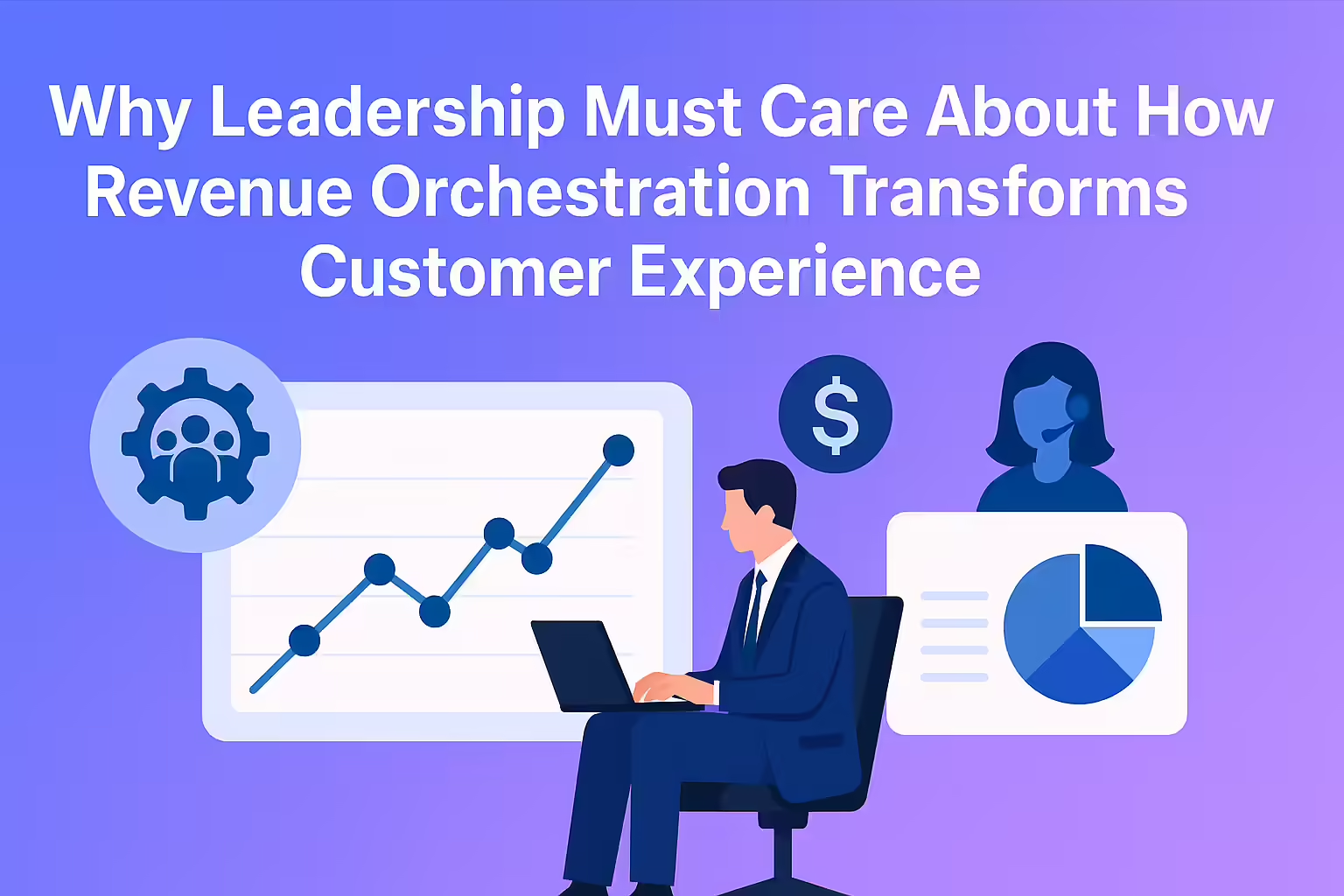The $75 Billion Blind Spot: Why a Disconnected Customer Experience is a C-Suite Crisis
The most significant threats to profitability and market share are often hidden in plain sight. For many organizations, the largest of these blind spots is the quality of their customer experience (CX). This is not a soft metric confined to support departments; it is a hard, quantifiable driver of financial performance. The evidence is stark: U.S. companies collectively lose a staggering $75 billion every year due to poor customer service. This is not a rounding error; it is a C-suite-level crisis that directly impacts revenue, erodes customer loyalty, and creates significant strategic vulnerabilities.
The modern customer operates under a new mandate. The experience a company provides is no longer a secondary benefit but a core component of its value proposition. Research shows that 80% of customers believe a company’s experience is as essential as its products and services, and a commanding 73% state that CX is the number one factor they consider when deciding whether to make a purchase. This paradigm shift has transformed the marketplace into a new battlefield where customer experience is the primary competitive differentiator.
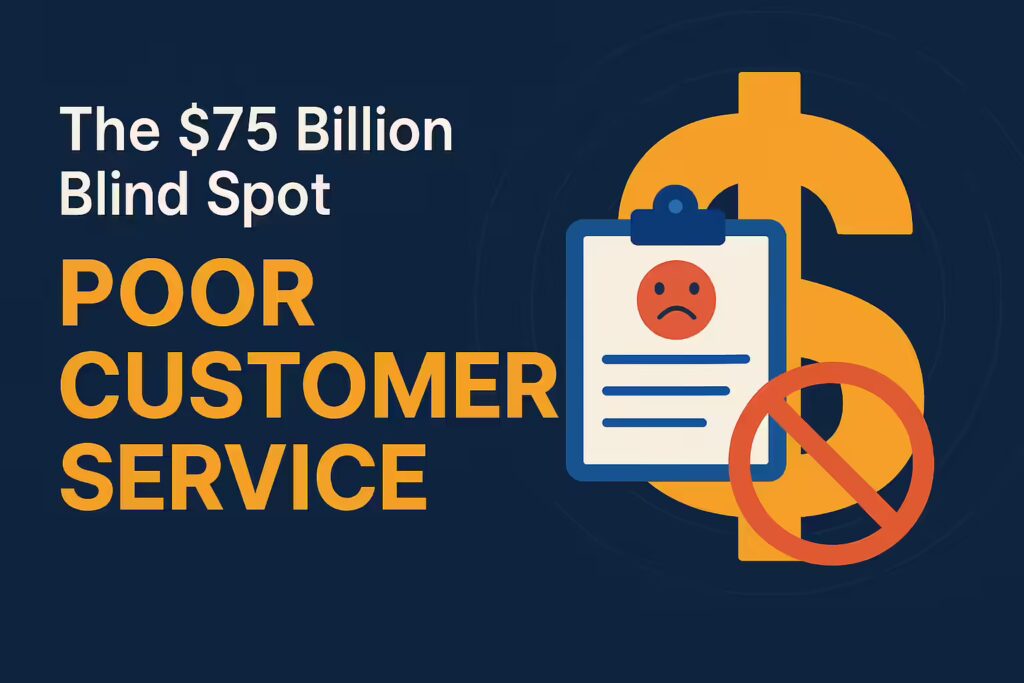
Failing to compete on this battlefield has immediate and severe consequences. A global study found that a staggering 82% of consumers report having a disconnected experience with businesses, a figure that has shown no improvement in recent years. The fallout from this widespread failure is catastrophic for customer retention. Nearly three-quarters (72%) of global consumers are willing to change service providers after a disconnected experience. This intolerance is even more pronounced among younger, high-value demographics; 78% of consumers aged 18-34 will defect after a poor journey. In fact, for 57% of customers, a single unsatisfactory interaction is enough to drive them to a competitor.
The financial implications are a tale of two outcomes. Companies that fail to prioritize CX are actively ceding ground and revenue. In contrast, those that become customer-centric see an 80% increase in revenue and report profits that are 60% higher than their less-focused peers. The message to leadership is unequivocal: in the modern economy, customer experience is not just a line item—it is a direct lever for growth or a catalyst for decline.
This reality exposes a critical perception gap within corporate leadership—a dangerous chasm between assumption and reality. While 80% of CEOs believe their organizations provide a superior customer experience, a mere 8% of their customers agree. This 72-point discrepancy is more than a simple misalignment; it represents a profound strategic intelligence failure. It means that a significant portion of business leaders are making critical decisions based on a fundamentally flawed understanding of their company’s performance in the market. They are operating in a self-constructed reality while their customers live in another, one defined by frustration and friction. This vulnerability is an open invitation for more attuned competitors to capture market share, not by out-innovating on product, but by simply out-performing on experience. The crisis is not just that CX is broken, but that the C-suite is often the last to know.
Compounding this intelligence failure is the complete evaporation of customer patience. In an era of instant gratification, loyalty has become a fragile commodity, and customer patience is, as one report notes, “threadbare”. Today’s consumers have “no qualms about switching to a competitor” if their expectations are not met swiftly and seamlessly. This is not an anecdotal observation; it is a measurable demand. 72% of customers want immediate service, and 45% expect their issue to be resolved in the very first interaction. This intolerance for friction means that operational latency—the delays caused by legacy systems, manual processes, and internal silos—is no longer a mere inefficiency. It is an active and powerful driver of customer churn. The market now directly punishes slow, disjointed operations. A company’s ability to provide a low-friction, real-time experience has been elevated from a back-office IT concern to a core tenet of competitive business strategy and survival.
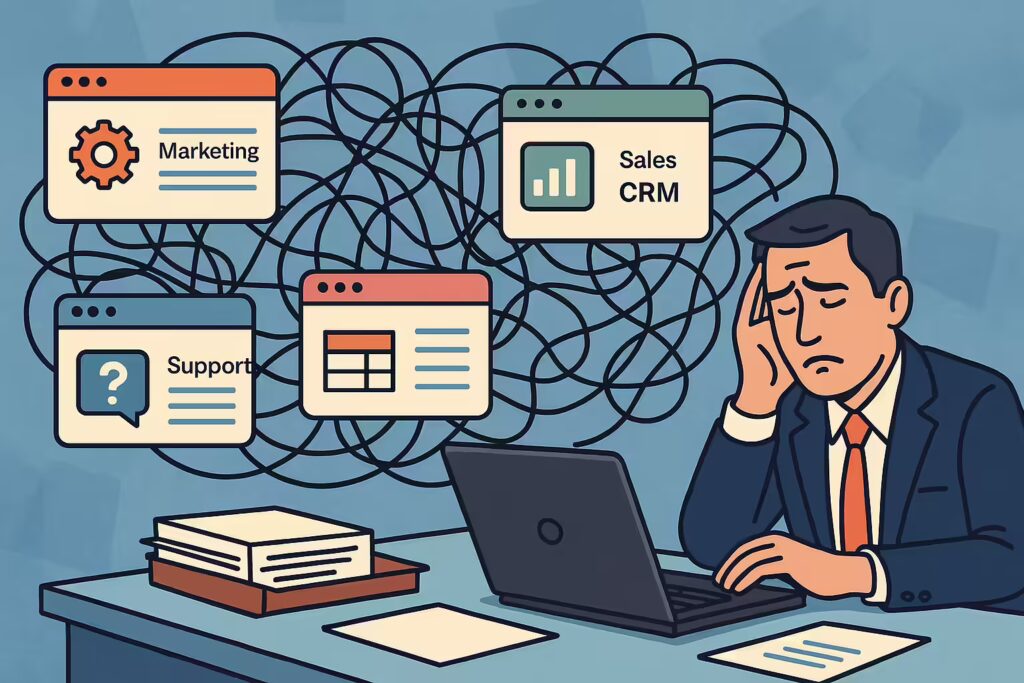
The Anatomy of a Broken Experience: Diagnosing the Chaos in Your Tech Stack
The crisis of the disconnected customer experience is not born from a lack of effort or investment. It is the direct and predictable result of a foundational, structural problem: a fragmented and chaotic technology stack. Over the last two decades, organizations have acquired technology in a piecemeal fashion, purchasing point solutions to solve specific, siloed problems. Marketing procured a marketing automation platform. Sales implemented a CRM. Customer support adopted a helpdesk tool. While each purchase was logical in isolation, the cumulative effect has been the creation of a “bloated tech stack full of point solutions that don’t work together”. This digital fragmentation is the root cause of the disjointed experiences that frustrate customers and hamstring revenue teams, leaving sales reps feeling overwhelmed and spending more time on administrative tasks than on actually selling.
This technological disarray manifests in several acute pain points that systematically degrade both internal operations and external relationships.
- Data Silos and Manual Error: The most immediate consequence of disconnected systems is the creation of data silos. Revenue-critical information becomes scattered and incomplete, trapped within the confines of individual applications. To bridge these gaps, employees are forced into tedious and error-prone manual data entry. One study found that 41% of employees in small and medium-sized businesses still manually transfer data between systems, a practice that kills productivity and introduces inaccuracies. This leads to low-quality, unreliable data in the very system that is supposed to be the “single source of truth”—the CRM.
- Inconsistent Customer Journey: When teams operate from different, incomplete datasets, the customer is the one who pays the price. They are forced to repeat their story to different agents, receive conflicting information from marketing and sales, and interact with support staff who have no context for their issue or history. This creates a jarring and frustrating journey, a sentiment shared by 73% of customers who report frustration with inconsistent experiences across departments. A powerful analogy from a recent analysis compares this to a malfunctioning car: if your vehicle’s core systems were as disconnected as your average CRM process, you would refuse to trust it on the road. Customers today apply that same logic to the businesses they patronize.
- Operational Inefficiency and Wasted Resources: Internally, disconnected systems breed rampant inefficiency. They lead to duplicated efforts, such as marketing and sales teams unknowingly targeting the same prospect with different messages. They waste marketing spend on campaigns that aren’t informed by real-time sales insights, and they drain employee productivity. Employees who are burdened with constantly navigating between different systems, copying and pasting information, and manually logging activities become frustrated, demotivated, and ultimately, less productive, leading to burnout.
- Strategic Paralysis: Perhaps most damaging for leadership, fragmented data makes it impossible to get a comprehensive, real-time view of the business. This leads to flawed strategic decision-making, inaccurate forecasting, and an inability to identify risks and opportunities in a timely manner. Without a unified view of the customer journey, leadership is flying blind.
This ecosystem of disconnected technology creates a vicious, self-perpetuating cycle that degrades both the customer experience (CX) and the employee experience (EX) in tandem. It begins with the fragmented systems that force employees into tedious, unfulfilling manual work, breeding low morale and burnout. This disengaged workforce, armed with incomplete data, inevitably delivers a poor and inconsistent customer experience. In turn, frustrated customers either abandon the brand or become more demanding, increasing the pressure on an already-strained team. This added stress further erodes the employee experience, fueling higher agent attrition—a costly problem, with estimates to replace a single agent exceeding $10,000. This is a negative feedback loop that attacks profitability from two fronts simultaneously: rising customer churn and escalating employee turnover costs. A strategic leader cannot view these as separate issues; they are two symptoms of the same underlying disease.
Ultimately, the “tool bloat” that plagues so many organizations is not just a technology problem; it is a physical manifestation of a deeper strategic misalignment. There is often a profound disconnect between what different departments believe constitutes success. IT leaders may express confidence that they have procured the necessary tools, while sales leaders lament that their teams lack the actionable, real-time insights needed to win deals. This gap leads to immense friction, with sales teams potentially overselling capabilities and tech teams building features that lack clear business value. The default response to these functional gaps is often to procure yet another point solution to patch the problem, which only adds to the complexity and further overwhelms the end-users. The chaotic tech stack, therefore, is a mirror reflecting a lack of a unified revenue strategy. The solution cannot be another isolated tool. It must be a unifying framework that forces strategic alignment across the entire go-to-market organization, from the first marketing touch to the final customer success interaction.
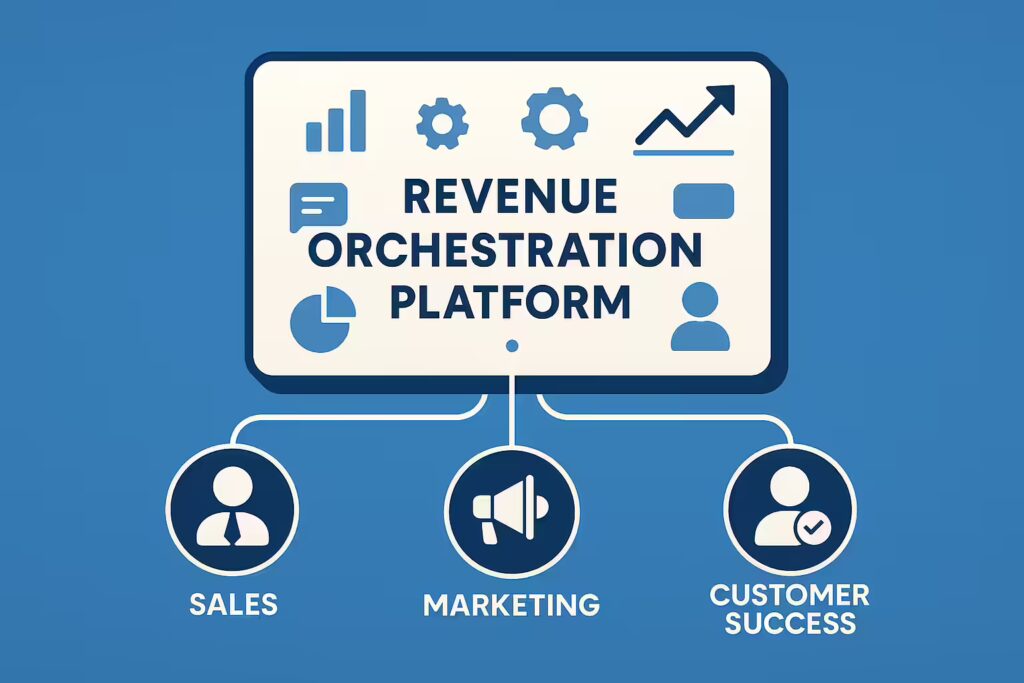
Introducing Revenue Orchestration as the Unified Command Center
The antidote to the chaos of a fragmented tech stack and a disjointed customer journey is not another point solution. It is a new strategic framework enabled by a revolutionary category of technology: the Revenue Orchestration Platform (ROP). This approach is designed to provide a comprehensive solution to the complexities of modern revenue generation, transforming the way organizations align their sales, marketing, and customer success teams to maximize performance. As defined by leading industry analysts at Forrester, ROPs “enable B2B organizations to orchestrate and maximize commercial performance from their revenue motions, including new logo acquisition as well as renewal and expansion motions for existing customer relationships”.
At its core, a Revenue Orchestration Platform acts as the central nervous system for all revenue-generating activities. It integrates once-disparate technologies—such as sasales engagementconversation intelligence, and real-time communications—into a single, unified workflow. This concept, often referred to as the “single pane of glass,” breaks down the data silos that compartmentalize valuable information, creating a single source of truth for all teams involved in the customer lifecycle.
However, orchestration is about more than just data aggregation. It represents a fundamental shift from a reactive to a proactive operational model. ROPs leverage artificial intelligence to analyze the torrent of interaction data—calls, emails, meetings, and CRM activities—to surface actionable insights and provide structured, dynamic guidance directly within a seller’s workflow. The platform doesn’t just present data; it translates that data into intelligent next steps. It moves teams beyond guesswork, equipping them with clear directives on “what to do, when to do it, why to do it, and whom to do it for”.
Kixie exemplifies this new paradigm, serving as a Revenue Orchestration Platform specifically architected to unify the most critical and often most fragmented part of the customer journey: real-time communication. As a “one-stop solution for revenue collaboration and management,” Kixie seamlessly integrates enterprise-grade calling and texting capabilities with the entire revenue tech stack, including over 25 native CRM integrations with platforms like HubSpot, Salesforce, and Zoho. By orchestrating every conversation, Kixie provides the connective tissue that transforms disjointed interactions into a cohesive and intelligent customer experience.
The strategic shift from a disconnected to an orchestrated model yields tangible dividends across the organization. The following table provides a clear contrast between the deficits of the old way and the benefits of the new, orchestrated approach.
| The Disconnection Deficit (The Old Way) | The Orchestration Dividend (The Kixie Way) |
|---|---|
| Fragmented Customer Data: Information is scattered across CRM, email, and call logs, creating an incomplete and inaccurate picture. | Unified 360-Degree Customer View: All interactions (calls, SMS, dispositions, notes) are automatically logged in one central CRM record, creating a single source of truth. |
| Reactive, Siloed Support: Agents lack context, forcing customers to repeat themselves and leading to inconsistent, frustrating experiences. | Proactive, Context-Aware Engagement: Teams have a complete customer history at their fingertips, enabling personalized, efficient, and high-quality service from the first second. |
| High-Friction Manual Tasks: Reps waste hours on manual dialing, data entry, and logging activities, which crushes productivity and morale. | Automated, Guided Workflows: Automation tools like power dialers, one-click dialing, and auto-logging free up reps to focus on high-value conversations that drive revenue. |
| Guesswork-Based Decisions: Leadership relies on incomplete, outdated, and subjective data for forecasting and strategy, leading to poor outcomes and missed targets. | AI-Powered, Data-Driven Insights: Conversation and sentiment analysis provide objective data on what strategies and phrases win deals, enabling predictable growth and accurate forecasting. |
| Inconsistent Cross-Channel Communication: A customer’s text message history is invisible to the agent who calls them, creating a jarring, unprofessional experience. | Seamless Omnichannel Experience: Unified calling and texting from a single platform ensures every touchpoint is consistent and informed by the last, building trust and continuity. |
From Disjointed to Deliberate: The Four Pillars of an Orchestrated Customer Experience
Understanding the strategic value of revenue orchestration requires moving beyond the high-level concept and examining the specific mechanisms by which it transforms the customer experience. A platform like Kixie does not merely connect systems; it enables a fundamentally different way of engaging with customers, built upon four distinct pillars. These pillars work in concert to replace disjointed, reactive processes with a deliberate, intelligent, and cohesive customer journey.
Pillar 1: Achieving a True 360-Degree View
The absolute foundation of any world-class customer experience is a complete, accurate, and instantly accessible view of the customer. Without this unified profile, every other effort at personalization or consistency is destined to fail. A true 360-degree view means consolidating every touchpoint—every call, email, purchase, and support ticket—into a single, chronological record that serves as the undisputed source of truth for the entire organization.
Revenue Orchestration Platforms are architected to build this view systematically. They achieve this by smashing the data silos that plague traditional tech stacks. Kixie, for example, is built around deep, bi-directional integrations with over 25 leading CRMs, including HubSpot, Salesforce, and Zoho. This is not a superficial connection. Every inbound and outbound call, every sent and received SMS message, every call outcome, and every agent note is automatically logged in the correct CRM contact record in real-time. This core function completely eliminates the need for manual data entry, which is a primary source of incomplete and inaccurate records. By automating this data capture, Kixie ensures that the CRM becomes a living, breathing repository of customer intelligence, creating the single source of truth that is essential for coordinated action.
Pillar 2: Empowering Teams with Context for Hyper-Personalization
In today’s market, personalization is not a luxury; it is a baseline expectation. A remarkable 71% of consumers now expect personalized interactions, and 76% report feeling frustrated when brands fail to deliver. The business impact is just as significant: companies that excel at personalization generate 40% more revenue from those activities than their average-performing peers.
A 360-degree view is the necessary prerequisite for any meaningful personalization. An orchestration platform like Kixie takes this a step further by layering artificial intelligence on top of this unified data to generate deep, actionable context. Kixie’s
Conversation Intelligence tools analyze every call for sentiment, track the usage of specific keywords and phrases, and provide objective call scoring. This gives managers and reps profound insight into what customers are truly saying, what pain points they are expressing, and what language resonates most effectively. This allows teams to tailor their communication based on objective data, not intuition. Furthermore, Kixie’s
Intelligent Call Routing (ACD) leverages the data within the CRM to automatically route an incoming call to the most appropriate agent—whether it’s the dedicated account owner or the rep who last spoke with the customer. This ensures that from the very first second of an interaction, the customer is connected with someone who has the context to help them efficiently, creating a seamless and highly personalized experience.
Pillar 3: Delivering Seamless Omnichannel Consistency
Modern customers do not interact with businesses through a single channel. They move fluidly between email, web chat, SMS, and phone calls, and they rightfully expect a consistent, unified experience regardless of the touchpoint. The stakes for getting this right are incredibly high. Research shows that companies with the strongest omnichannel customer engagement strategies achieve a staggering
91% greater year-over-year customer retention rate compared to businesses that do not.
Revenue orchestration is the key to delivering this consistency. Kixie is fundamentally a unified communications platform designed specifically for the needs of revenue teams. It consolidates the most critical real-time channels—calling and SMS—into a single, integrated interface. This simple but powerful unification prevents the jarring and unprofessional experiences that occur when a customer’s conversation history is fragmented. With Kixie, a sales rep can review a prospect’s recent text message exchange and then immediately initiate a phone call with full context, or send a follow-up text that references a point made during a prior call. This eliminates the siloed communication that forces a customer to ask, “Don’t you guys talk to each other?”. Features like
Team SMS, which provides shared inboxes for customer text conversations, further break down internal walls, allowing an entire team to collaborate on serving a customer, ensuring that no matter who responds, they have the complete history of the conversation.
Pillar 4: Automating the Mundane to Humanize the Meaningful
The ultimate goal of technology should be to free up a company’s most valuable asset—its people—to focus on the uniquely human tasks that drive value: building relationships, solving complex problems, and showing empathy. Revenue Orchestration Platforms are designed to systematically automate the repetitive, low-value administrative tasks that consume an inordinate amount of a seller’s time.
Kixie exemplifies this principle through a suite of powerful automation tools. The Multi-line Power Dialer can dial up to 10 leads simultaneously, intelligently skipping voicemails and IVR systems to connect reps only with live humans, dramatically increasing talk time. The
one-click dialing feature embedded directly within the CRM eliminates the manual process of looking up and punching in numbers. And as mentioned, the
automated logging of every call and text saves countless hours of administrative work. The impact of this automation is profound. One Kixie client, a healthcare collective, found that its agents saved an average of
2 hours each day—time that was previously spent on manual, repetitive tasks. This reclaimed time is a strategic asset that can be reinvested directly into higher-quality, more thoughtful, human-to-human interactions that build lasting customer loyalty.
This approach reveals that true personalization is not merely about using a customer’s first name in an email. It is about demonstrating a deep, institutional understanding of their history and needs. When an agent, empowered by an orchestrated platform, can initiate a conversation by saying, “Hello John, I see we spoke last week about the integration issue, and I have an update for you,” they are delivering a fundamentally different and more valuable experience than one that simply starts with a generic greeting. This act of “remembering”—of showing the customer that their past interactions have been heard, recorded, and valued—builds a level of trust and rapport that generic marketing tactics can never achieve. It shifts the dynamic from a transaction to a relationship.
Similarly, the greatest return on investment from automation is not just the raw efficiency gain; it is the redeployment of human empathy. The first-order benefit of saving an agent two hours per day is a clear productivity win. The second-order benefit is what that reclaimed time is used for. Instead of mind-numbing data entry, that agent can now participate in call coaching sessions, conduct deeper discovery with clients, or strategize on complex deals. The third-order benefit is the direct impact on the customer. An agent who is less stressed, better prepared, and more engaged in their work is infinitely better equipped to demonstrate the empathy and patience required to solve difficult problems and build genuine connections. For leadership, the strategic insight is clear: automation is not a tool for reducing headcount. It is a tool for elevating the function of your existing talent. By automating the “robot work,” you unlock and amplify the uniquely human skills that create a truly differentiated and defensible customer experience.
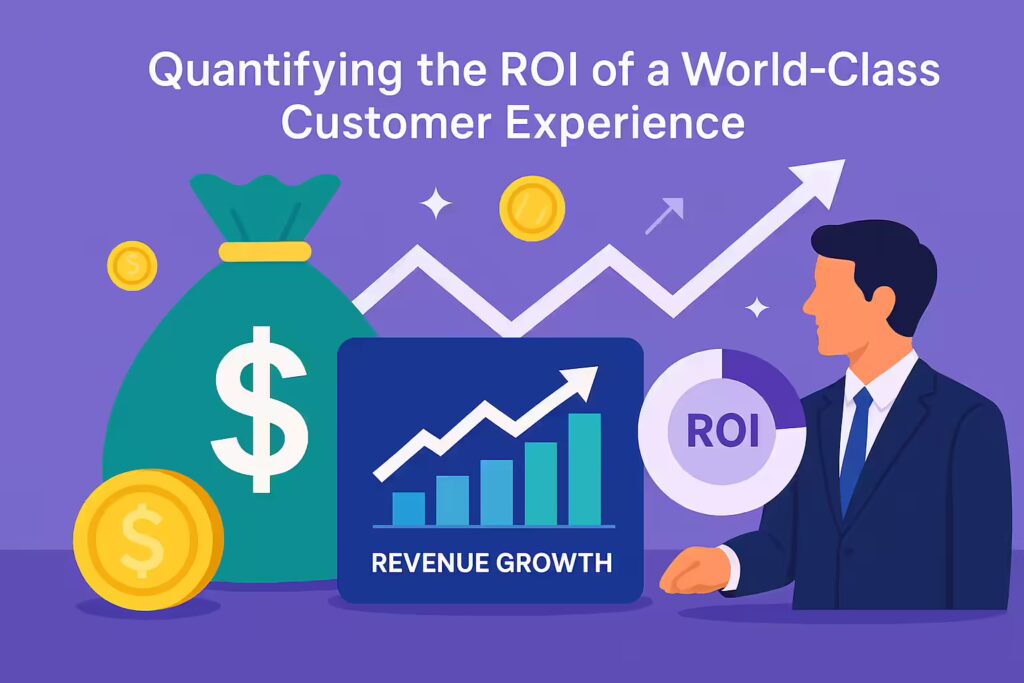
The Leadership Payoff: Quantifying the ROI of a World-Class Customer Experience
The strategic decision to adopt a revenue orchestration framework is ultimately an investment decision. For leadership, the crucial question is not whether an orchestrated experience is better for the customer, but whether that improvement translates into tangible, measurable financial returns. The data provides a clear and compelling answer: investing in a superior, orchestrated customer experience is one of the highest-ROI initiatives a modern business can undertake. The benefits are not abstract; they manifest directly in accelerated revenue growth, enhanced profitability, and a significant increase in the long-term value of the entire customer base.
Igniting Revenue Growth and Profitability
There is a direct and causal link between the quality of a company’s customer experience and its top-line growth. This is not a correlation; it is a core driver of financial performance. Organizations identified as “customer-obsessed” report 41% faster revenue growth and 49% faster profit growth than their less mature peers. More broadly, companies that successfully implement projects to improve their CX can expect to boost their revenue by a substantial
10-15%.
This growth is fueled by the multiplier effect of an orchestrated system. By providing teams with the context and tools to deliver consistent, personalized interactions, orchestration directly impacts key sales metrics. For instance, businesses with well-integrated systems that provide a unified customer view see an average order value that is 73% higher than those operating with poor integration. This, combined with higher conversion rates driven by more effective, data-informed engagement, creates a powerful compounding effect that accelerates revenue far beyond what siloed efforts can achieve.
Maximizing Customer Lifetime Value (CLV) and Fortifying Retention
While acquiring new customers is essential, the most profitable path to sustainable growth lies in retaining and expanding relationships with existing ones. The economics are undeniable: it costs 5 to 10 times more to acquire a new customer than it does to retain a current one. This makes customer retention the single most critical lever for profitability. The impact is exponential: a mere
5% increase in customer retention can increase profitability by an astounding 25% to 95%. Loyal customers are a company’s greatest asset; they spend more over time, make more frequent purchases, are less sensitive to price changes, and are more willing to try new products.
Customer Lifetime Value (CLV) and retention are inextricably linked. They are positively correlated, meaning that as your retention rate increases, your average CLV increases with it—often at an exponential rate, especially at higher retention levels. An orchestrated customer experience that reduces friction and increases satisfaction is a direct driver of retention, and therefore, a direct driver of CLV. This is a critical connection that many businesses fail to make. A stunning
70% of companies do not have their customer experience data linked to revenue, meaning they are unable to calculate the ROI of their CX programs. This is a massive strategic blind spot that revenue orchestration is specifically designed to eliminate, transforming CX from an unquantifiable expense into a measurable driver of long-term enterprise value.
This shift in perspective is transformative. When organizations can clearly see the connection between experience and revenue, they begin to manage customer service not as a cost center, but as a value center. The results are dramatic: companies that successfully make this shift experience 3.5 times more revenue growth than those that do not. An investment in a revenue orchestration platform like Kixie is therefore not an operational expense. It is a strategic investment in a predictable revenue engine, enabling leadership to manage and optimize their customer experience with the same financial rigor they apply to their sales and marketing investments.
Orchestration in Action: Real-World Results with Kixie
The theoretical benefits of revenue orchestration are validated by the concrete, measurable results achieved by companies that have adopted this approach. The Kixie platform has consistently enabled businesses across various industries to overcome critical communication challenges and drive significant performance improvements.
- Demonstrating Productivity and Efficiency: Fischer Homes, a major home builder, faced the challenge of needing to dramatically increase their outreach to potential buyers. By implementing Kixie’s orchestration platform, they were able to streamline their calling processes and empower their inside sales team. The result was a 300% increase in outbound call volume, allowing them to connect with significantly more prospects without a corresponding increase in headcount.
- Impacting Direct Sales Outcomes: For Solar Power Pros, a high appointment no-show rate was a direct impediment to revenue. Each missed appointment represented a lost sales opportunity. Using Kixie’s integrated communication tools to improve confirmation and reminder processes, the company was able to reduce its no-show rate by a remarkable 50%, directly translating to more sales conversations and closed deals.
- Ensuring Scalability and Financial Return: GoSite, a company managing a massive volume of 150,000 cold calls per month, needed a platform that could handle their scale while improving efficiency. Kixie’s robust infrastructure and automated dialing features allowed them to not only manage this volume but also boost agent talk time and the overall ROI of their outreach efforts.
- Enabling Scalable Growth: Kennected, a marketing and lead generation firm, sought to expand its operations and needed to scale its call volume accordingly. With Kixie’s platform, they successfully doubled their call volume, demonstrating the system’s ability to support and accelerate business growth.
These cases illustrate a clear pattern: orchestrating communications is not just about improving conversations; it is about driving measurable business outcomes—more productivity, higher conversion rates, and scalable, profitable growth.
The First Step for Forward-Thinking Leaders
The evidence is conclusive. In the modern economy, the customer experience is the primary determinant of business success or failure. The market punishes disconnected, frustrating journeys with staggering financial penalties, from lost revenue to customer churn. This widespread disconnection is not an accident; it is the inevitable outcome of a fragmented technology stack and a lack of strategic alignment across revenue-facing teams.
Revenue Orchestration provides the definitive strategic framework to solve this crisis. It is the force that unifies technology, aligns people, and streamlines processes into a cohesive, intelligent system focused on a single objective: delivering a superior customer experience that drives predictable growth.
This presents a clear and urgent choice for every business leader. The first path is the status quo: a future of fragmented tools, reactive processes, departmental silos, and unpredictable revenue cycles. The second path is the orchestrated future: one of unified workflows, proactive data-driven engagement, seamless customer journeys, and accelerated, durable revenue outcomes.
The journey to this orchestrated future begins by acknowledging a fundamental truth: a unified communication strategy is the heart of any world-class customer experience. It is the essential first step toward empowering every customer-facing team—Marketing, Business Development, Sales, and Customer Support—to collaborate effectively and engage customers from a single, consistent source of truth.
The time has come to move beyond managing isolated departments and siloed technologies. The future belongs to those who can conduct a symphony of seamless interactions across the entire customer lifecycle.
Stop managing departments. Start orchestrating revenue.
See how Kixie’s Revenue Orchestration platform can unify your teams and transform your customer experience.


